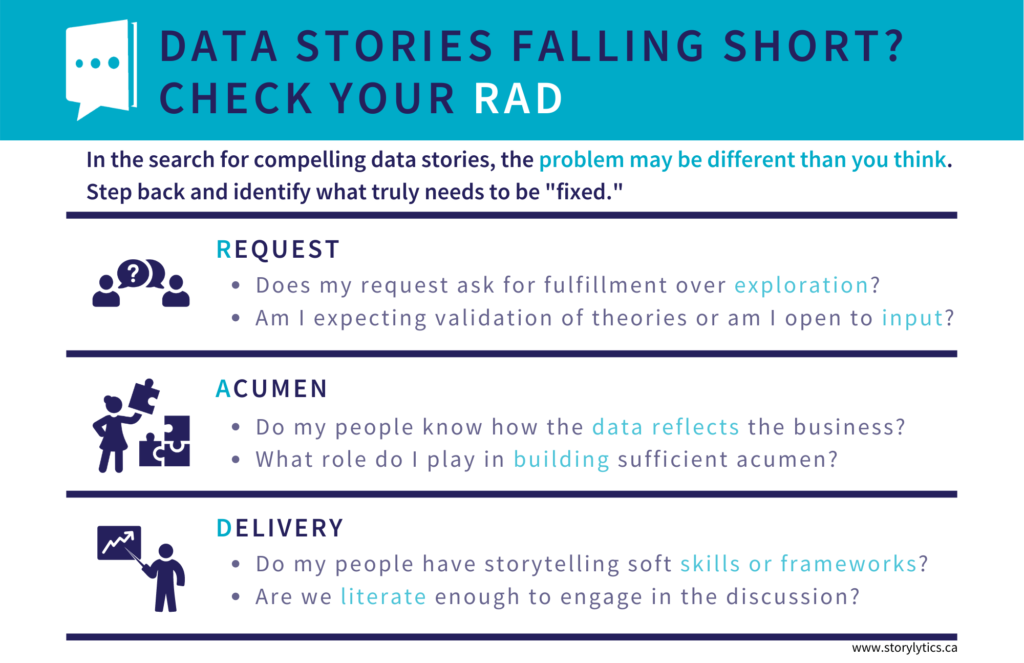Data isn’t supposed to be aggravating. It’s supposed to be enlightening, empowering. At its best, it reveals opportunities, forces major rethinking or spells out a need to pivot. But often, when the data does not deliver what’s desired, needed or expected, people can become frustrated. And further still, they don’t know why the data isn’t delivering.
Here are some of the things I hear when speaking with exasperated leaders: rework upon rework; reams of data with no analysis; recommendations that aren’t feasible; or no critical thought applied or opinion offered based on the data. I’m quite sure you can add your own examples to the list as well. But I’ve learned something important over the years: No matter the frustration, the analytic experience likely goes off the rails at one of three points in the process—at the request stage, with the acumen of your people or in the data story delivery (so RAD!). The trick is to figure out where the problem lies in order to course-correct and move in the right direction.
Start with the Request
It might seem like a simple enough thing, but how and what you ask for matters more than you may realize. Without the right request, you’re stalled before you’ve even started the journey—it’s akin to a boat just circling the harbour without actually heading toward a destination. This happens when there is a problem with the data in the first place, or when an organization has created an environment where data is only there to validate a foregone conclusion. So, how do you know if this is where your problem originates? Ask yourself these questions:
- Can your data do what you need and want it to do?
- Are you open to different answers or are you looking to confirm a preferred course of action?
- Do your specialists believe they have the freedom to explore the question?
Chances are, your data is usable. I mean, it can always be better but at this stage of the big data era, it’s more of an exception than the rule to suddenly discover deep, systemic issues with your data that renders it unusable (not impossible, just less likely). If you discover this truly is the case, revisit the data and invest in resolution. I’ll be here when you get back.
With that, have a seat—we need to have a tough conversation.
It’s not uncommon for me to hear analysts say that their job is to cherry-pick the data that will make their executives happy. While I am quick to assure them that isn’t really the case, the reality is often (and I’ve lived it) that it feels much easier—safer, even—to go with the “keep ‘em happy” approach, rather than to bring forward information that challenges the beloved belief of a strong-willed executive.
If you’re a decision-maker and you’re just asking your people to shore up a predetermined solution or back up a hypothesis, rather than allowing your team to find you stories that will move the needle, you’re doing your business a disservice. Being self-aware enough to recognize that your culture isn’t conducive to true data storytelling is a big ask, but it also has the potential for big payoff—even if the results are difficult to hear and even more difficult to implement (remember, adversity breeds momentum!). Sometimes a change is as simple as asking, “Does the data show anything different?”
Consider How Acumen is Built
Now that we’ve considered the request phase, let’s look at what’s happening when your people are getting into the data itself—the analysis. Odds are, the technical chops of your employees aren’t the issue (so no immediate need to clean house!). Good to go, right? Maybe. But you need to go a step further and ask yourself these questions:
- Do your people understand the fundamentals of your business?
- Do they understand how the data reflects what is happening in the business?
Your people may be skilled at pulling the data together, but to truly get at the business truths you need, they also require a degree of business acumen—an understanding of your industry and your organization, as well as the problem at hand (no acumen, all the analytics in the world won’t make a difference). This goes beyond the technical and into an ability to think through and manipulate the data, to calculate and interpret what the data means, with a specific business or issue in mind. Here’s the disconnect: An analyst might understand the data in front of them, but they need the business mind to comprehend, too. There is nuance and elegance to finding meaningful data stories as they relate to each individual scenario. Trying to get data to deliver if no one working with the data has a fundamental understanding of how the business works will find you barely treading water in a sea of information.
Here is my favourite example of just how important business acumen is: During my early days at Nielsen, when reviewing presentations was a part of my learning experience, I once asked my manager why I hadn’t seen the recommendations about getting more display in stores—really, from the data, it seemed like display had the biggest impact on promotional sales. I’ll never forget the conversation. She told me that we needed to remember how retail actually works. That even though display may be the best way to drive sales, it’s extremely difficult to secure—this means that display is not always a reasonable, feasible recommendation for driving sales volume. To this day, this remains my clearest example of how business acumen helps to make data actionable. We cannot assume the people working with the data have the knowledge required. We need to ensure our people have the opportunities to learn the business in order to effectively analyze it.
Deliver Impactful Stories
By this point, you should be confident in your request, know that your environment welcomes data and be comfortable that your team has sufficient acumen. You’re navigating the ocean and can see the port ahead. But you’re not home free yet—we need to bridge the message to the audience in an effective way. Bottom line: When the data speaks, the last leg of the journey is to figure out how to make others listen. Consider these questions:
- Does the specialist have the soft skills necessary to transform their data into a story that will engage, connect and inspire the audience?
- Do they have the frameworks required to design and deliver a story?
- Does the audience speak enough of the language to make communication possible? Or are they travellers in a foreign country and even the most effective communicator will have trouble getting their idea across? (Although, this is a conversation for another day.)
Connecting with your audience is key. We need to be able to translate the information we get from our data into a narrative people will hear, on their level, on their terms. This is where the ability to communicate data stories becomes paramount. The data might do everything it needs to do up until the moment of delivery, but without a great narrative, it will fall short. This is critical, as a successful data story will help lead to better, faster decisions that allow a business to be more competitive. If delivery is your issue, the good news is that you don’t have to go back to the beginning. You need to drill down on your data story delivery, consider the audience’s understanding (and their data acumen—this isn’t just an analyst thing) and go at it again.
Data shouldn’t be frustrating. If it is, you need to take a good, hard look at the why. I’m betting it’s one of the reasons I’ve outlined above, but the good news is, I can also guarantee the fix isn’t out of reach.

